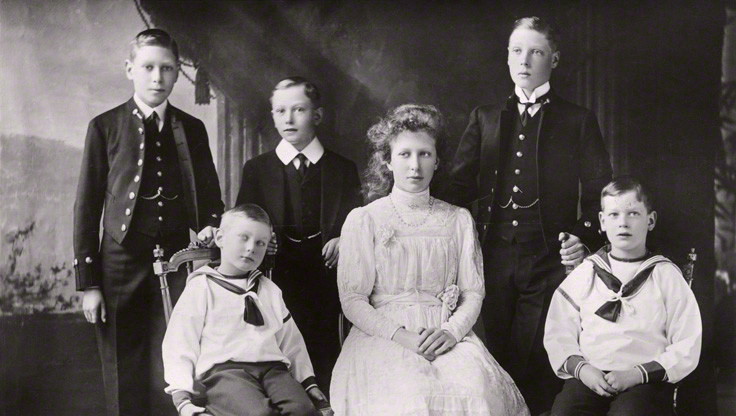by Susan Flantzer © Unofficial Royalty 2013

Prince John of the United Kingdom, 1918; Credit – Wikipedia
Prince John Charles Francis was the fifth son and the sixth and youngest child of King George V of the United Kingdom and Queen Mary. He was born on July 12, 1905, at York Cottage on the Sandringham Estate in Norfolk, England. At the time of his birth, his parents were the Prince and Princess of Wales, so he was styled His Royal Highness Prince John of Wales until his father became king in 1910 and then he was styled His Royal Highness The Prince John. He was called Johnnie in the family.
John had four brothers and one sister:
- King Edward VIII (Duke of Windsor after his abdication) (1894-1972), married Wallis Simpson, no children
- King George VI (1895-1952), married Lady Elizabeth Bowes-Lyon, had two daughters
- Mary, Princess Royal (1897-1965), married Henry Lascelles, 6th Earl of Harewood, had two sons
- Prince Henry, Duke of Gloucester (1900-1974), married Lady Alice Montagu-Douglas-Scott, had two sons
- Prince George, Duke of Kent, (1902-1942), married Princess Marina of Greece, had two sons and one daughter
John was christened on August 3, 1905, at St. Mary Magdalene Church on the Sandringham Estate. His godparents were:
- King Carlos I of Portugal
- The Duke and Duchess of Sparta (both his father’s first cousins, the future King Constantine I and Queen Sophie of Greece, born Princess Sophie of Prussia)
- Prince Carl of Denmark (his father’s first cousin, later King Haakon VII of Norway)
- Princess Alice of Albany (his father’s first cousin)
- Prince Johann of Schleswig-Holstein-Sonderburg-Glücksburg (his great-great-uncle)
- Alexander Duff, Duke of Fife (his uncle by marriage)

John and his siblings in 1912, Credit – Wikipedia
For the first four years of his life, John appeared healthy, but at the age of four he suffered his first epileptic seizure, and his condition gradually worsened. John grew up with his four brothers and one sister, moving with the family from one royal residence to another until 1917 when doctors advised that he be separated from his siblings because his seizures upset them. Most likely it was because John’s condition had deteriorated. Besides epilepsy, it is quite possible that John also had a mild form of autism.
A household was set up for John at Wood Farm on the Sandringham Estate and John lived there under the care of his nanny Charlotte Bill who was called Lala. Other staff at Wood Farm included John’s tutor Henry Peter Hansell, Thomas Haverly, a coachman who took John on outings in the country or to the sea, and to the ‘big house’ at Sandringham, a cook named Kate Bennett, whose niece Hilda Simpson was the live-in maid. Photos show John riding a bicycle and a horse without assistance. He had his own garden plot, “Prince John’s Garden.”
A young girl named Winifred Thomas, who suffered from asthma and had been sent to the country to live with her aunt and uncle, was John’s companion. Winifred visited John nearly every day and the two went on walks and cared for the garden. Later in life, Winifred recounted John’s excitement at watching zeppelins passing over Sandringham in 1916 and his pleasure in meeting ‘a real, live soldier’, her father Sergeant Frederick Thomas who visited that same year. She also remembered his mother Queen Mary as a loving and interested parent who spent much with her son. John’s grandmother Queen Alexandra also visited him often.

Lalla Bill and Prince John; Credit – Wikipedia
Until the early 20th century, epilepsy was often considered a psychological or behavioral dysfunction, and people with epilepsy were routinely confined to asylums. It appears that John was well looked after at Wood Farm and while it may have seemed cruel to separate him from his family’s everyday life, had he been born to an ordinary family, his fate would probably have been worse. The evidence suggests that he remained a happy child while at Wood Farm.
After John turned 13, his seizures became more frequent and severe. On the morning of January 18, 1919, John had a very severe seizure and died peacefully in his sleep at 5:30 that afternoon at Wood Farm in Wolferton in Norfolk, England, most likely from Sudden Unexpected Death in Epilepsy or SUDEP. Queen Mary wrote in her diary, “The news gave me a great shock, tho’ for the poor little boy’s restless soul, death came as a great release.” John was buried in the churchyard at St. Mary Magdalene Church on the Sandringham Estate in Norfolk, England next to his uncle of the same name who lived only one day. His grandmother Queen Alexandra wrote to Queen Mary, “Now our two Johnnies rest side by side.”
This article is the intellectual property of Unofficial Royalty and is NOT TO BE COPIED, EDITED, OR POSTED IN ANY FORM ON ANOTHER WEBSITE under any circumstances. It is permissible to use a link that directs to Unofficial Royalty.

